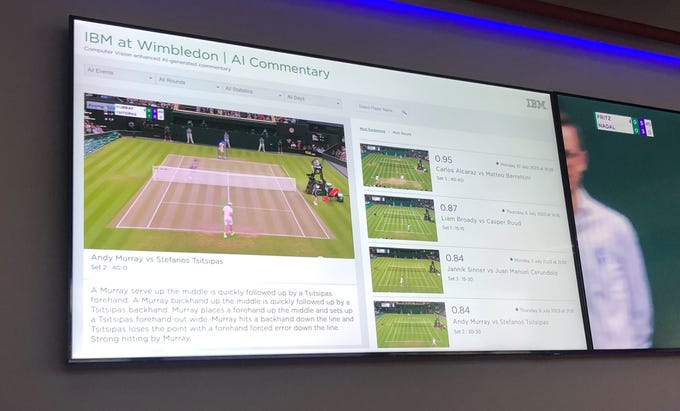Generative AI Operations In the Control Room at Wimbledon 2023
A look behind the scenes of the new digital tools from IBM, bringing more emerging technologies to the courts

At a Glance
- This year’s Wimbledon saw the introduction of generative AI using IBM’s watsonx to generate automatic, live match commentary.
- Watsonx was trained in the language of tennis to add another level to these highlight reels – automatic commentary.
This year’s Wimbledon tournament saw the introduction of generative AI, using IBM’s watsonx to generate automatic, live match commentary.
In what the partners call “a first for tennis,” IBM is also providing an AI Draw Analysis feature that quantifies each player’s likelihood of success in the singles draw.
IoT World Today toured the control room where all these insights are gathered and found out how it all works.
“We use a process called the IBM garage method,” said Kevin Farrar, IBM’s U.K. sports partnership leader. “It uses design-thinking to put fans at the heart of it. There are different personas of fans that need to be taken into consideration – some tennis fans tune into Wimbledon for a fortnight, some are all year round, others are deep into the stats, but all are considered when designing the user experience.
“We start with paper and pen, and decide how emerging technologies can be used to engage these fans, and what features to deploy.”
.jpg?width=678&auto=webp&quality=80&disable=upscale) Leveraging generative AI to create match commentary was one such idea.
Leveraging generative AI to create match commentary was one such idea.
“We’ve been producing highlights reels post-match for the last five years, using AI to listen to noise of the crowd and monitor gestures of the players to determine the ‘excitement level’ of each moment,” said Farrar. “These moments are then pulled into a compilation of highlights which are sent to the content team for a final edit.”
This year, IBM’s watsonx AI platform was trained in the language of tennis to add another level to these highlight reels – automatic commentary. Intended to be different to radio-style commentary, the model identifies key moments in the match and produces a narration.

Data to generate the commentary is taken from a range of sources to provide a pool of structured and unstructured data, which IBM’s Watson Discovery program then sifts through.
“Data is filtered to make sure it’s trusted, compliant and without bias,” said Farrar. “We used one of the IBM foundation models to sort through the data pile. In this case, we used one called Sandstone because it�’s best for the sports context, though there are models trained for different industries such as financial services or retail.”
According to Farrar, around 130 million data documents are analyzed and used to train the model. Several are generated to describe different actions on the court, with the AI model selecting the best choice for the match.
“We also wove computer vision into the mix,” said Farrar. “Using this, we’re able to identify shot types, as well as other things that are happening on the court such as how long it takes a player to return to their starting position, how many times they bounce the ball before serving. All this adds color to the commentary.”
Once the model has studied enough players, it can begin to build profiles on each player to identify specific game style or technique.


This year’s AI-generated commentary is reportedly the first step on a longer journey to produce AI commentary for live matches, though Farrar stressed it is always intended to work alongside, rather than replace, human commentators.
“This is about making matches accessible that don’t currently have commentary – wheelchair, juniors, seniors, under 14s,” said Farrar. “We’re filling a gap, not replacing the commentators we all know and love. It’s more about humans and computers working together to make more matches available to more people around the world.”
Draw analysis
The draw analysis feature leverages existing data from Wimbledon and IBM’s power index, introduced as an AI-generated analysis of player performance.
Using this information as well as unstructured data from sources such as media reports and social media, the draw analysis can forecast player performance and the favorability of the draw against each player.
“This is a dynamic, visual way to engage with fans,” said Farrar. “People can visualize the draw, explore it and see the favorability of their favorite players. The human element is also vital in this aspect. We have a team of tennis specialists and data scientists who have access to all the stats history going back to the first tournament – looking for stories, records about to be broken – and can alert journalists of a story before it breaks.”
This article first appeared on IoT World Today. To get the latest IoT content straight to your inbox, subscribe to the newsletter.
About the Author(s)
You May Also Like


.jpg?width=700&auto=webp&quality=80&disable=upscale)
.jpg?width=700&auto=webp&quality=80&disable=upscale)
.jpg?width=700&auto=webp&quality=80&disable=upscale)
.jpg?width=300&auto=webp&quality=80&disable=upscale)
.jpg?width=300&auto=webp&quality=80&disable=upscale)
.jpg?width=300&auto=webp&quality=80&disable=upscale)

.jpg?width=300&auto=webp&quality=80&disable=upscale)